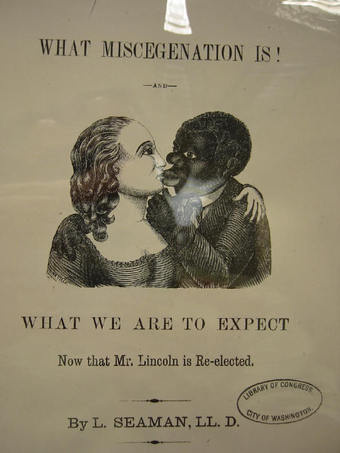тАЬNon-marital sexual relationships between foreigners and Lao citizens are against the law, as are various forms of cohabitation with Lao nationals. Convictions for such offences CAN lead to prison sentences and large fines. Improper registration of a relationship to a Lao national can lead to similar sentences. Permission for marriage or engagement to a Lao citizen must be submitted in a formal application to Lao authorities.тАЭ
Originally Posted by combat
1864, Library of Congress Prints and Photographs Division
тАЬThe United States is one of a few countries in the world to have enacted laws restricting and prohibiting sex and marriage between whites and blacks or other persons of color. Nazi Germany and South Africa share most famously in this dubious distinction. [...] The bans in Germany and South Africa began and ended during the twentieth century. But American prohibitions against interracial sex and marriage began in the 1600s тАУ almost as soon as white Europeans and black Africans set foot on the shores of the New World тАУ and persisted, in some cases, until the turn of the millennium. Even in the colonies where slavery did not become the basis of the socioeconomic system, some legislatures enacted laws on interracial sex and marriage. Among the original thirteen colonies, all except Connecticut, New Hampshire, and New Jersey enacted laws punishing sex and marriage across the color line.
Most of the colonies that did establish such laws had them in place by 1750. Maryland and Virginia enacted the earliest statutes during the 1660s, and the laws from these two colonies seem to have provided a blueprint for those enacted elsewhere. In each colony, the prohibitions were directed at whites and тАЬNegroes or mulattoes,тАЭ and in some cases between whites and Native Americans, but the matter of which behaviors were prohibited varied greatly from colony to colony. As of 1700, Delaware and South Carolina forbade bastardy and/or fornication but not marriage, while Rhode Island prohibited marriage only, Georgia and Massachusetts outlawed illicit marriage and sex, and the other colonies proscribed some combination of fornication, bastardy or marriage. And by 1800, in every colony that banned interracial sex and/or marriage, all except Delaware, Georgia, and South Carolina also punished ministers or magistrates for solemnizing a marriage ceremony between a white person and a person of color. Ten of the thirteen original colonies thus enacted bans or restrictions on intermarriage within one hundred years after settlement.
In the history of the American colonies and states, only eight never restricted or banned interracial relations: Alaska, Connecticut, Hawaii, Minnesota, New Hampshire, New Jersey, Vermont, and Wisconsin. Following the Civil War and the emancipation of slaves, such laws burgeoned, particularly in the West, where some legislatures prohibited relations between whites and Native Americans, Chinese, Mongolians, Japanese, Filipinos, or тАЬHindoosтАЭ as well as those between whites and African Americans. For a brief period after the war, Mississippi lawmakers went so far as to make marriage between white and black persons a felony punishable by life imprisonment. In the thirty years following the war, six southern states тАУ Alabama (1865), Tennessee (1870), North Carolina (1875), Florida (1885), Mississippi (1890), and South Carolina (1895) тАУ even amended their state constitutions to include bans on intermarriage. and in two of these six states, the prohibitions did not officially end until 1998 and 2000 тАУ some thirty years after the U.S. Supreme Court had declared them unconstitutional.тАЭ
Fay Botham, Almighty God Created the Races: Christianity, Interracial Marriage, and American Law, 2009: 51-53









 Reply With Quote
Reply With Quote
